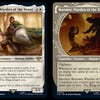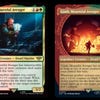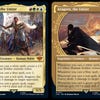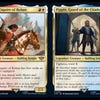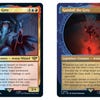MTG Tales of Middle-earth Mechanics: Tempting Rings, tempting food and amassing Orcs
Or… tempting Orcs?
Magic: The Gathering - Tales of Middle-earth translates the fantastical world of J.R.R. Tolkien’s novels into a fully fledged set for the popular trading card game. Not only will beloved characters be represented through new art but also the TCG’s mechanics. What does The One Ring look like through the lens of rules?
That’s actually one of two main mechanics in Tales of Middle-earth, and it’s a bit wordy on first blush albeit appropriate for the crossover release based on The Lord of the Rings’ 576,459 across all three novels.
True to its narrative and diegetic potency, The One Ring will play a pivotal role in Tales of Middle-earth. Many cards in the set will state that “the Ring tempts you” in its rules text box. This lets you know that it's time to introduce the Ring and its influence to the game, if you haven’t already. The first time this happens, the tempted player creates an emblem token ominously called The Ring. Booster packs will helpfully contain one for use during limited events, and it contains all the rules for using it.
After The Ring enters play (it lives in the Command Zone, technically), it gains its first ability, and one of the tempted player’s creatures is chosen as the Ring-Bearer. Each successive temptation unlocks the next ability on the track and gives the player a chance to switch Ring-Bearers - they can also keep the same one, if they wish. Just like there is only one Ring, there can only be one Ring-Bearer per player, and they all unlock abilities at their own pace.
So, what sort of power does The Ring bestow? Initially, it makes the Ring-Bearer a legendary creature that can’t be blocked by other creatures with greater power. Like the unassuming Hobbit who carried The Ring all the way to Mount Doom, smaller creatures benefit more from this ability. The second ability states, “Whenever your Ring-Bearer attacks, draw a card, then discard a card.” This is perfect for a sneaky little guy looking for holes in your opponents’ defences.
On the third tempting, The Ring gains, “Whenever your Ring-Bearer becomes blocked by a creature, that creature’s controller sacrifices it at the end of combat.” The specific wording of ‘sacrifice’ slinks past indestructible creatures’ invulnerability and makes this a mighty boon. The last ability, “Whenever your Ring-Bearer deals combat damage to a player, each opponent loses three life,” will slowly whittle away the competition unless they want to dedicate some serious resources.

The second main mechanic, Amass, is actually a returning keyword with a specific Orc-y flavour this time. Whenever a card tells you to amass, either create a 0/0 Orc Army creature token if you don’t have any, or put a +1/+1 counter on any Army you currently control. The card will also have a number printed beside it telling you how many counters to place. For example, Sauron, The Lord of the Rings says to Amass 5 when he enters the battlefield, meaning you would put five +1/+1 counters on an Orc Army token.
The only other thing to note about Amass is that it turns any Army creature into an Orc with its counters. Amass was initially a Zombie-only mechanic, but now those older cards and Changelings - which are all creature types simultaneously - can let us know what’s back on the menu, too!
The last mechanic of real import is Food Tokens, which publisher Wizards of the Coast said was an obvious addition to the world that brought us Hobbits and their hearty appetites. Several cards in Tales of Middle-earth will create Food tokens, such as Bill the Pony and Samwise Gamgee in one of the preconstructed Commander decks. They still work normally - pay two Mana and tap them to sacrifice the token and gain 3 life - but this set will deliver plenty of delectable renditions of pies, roasts, bread, cheese and, well… perhaps some webbed victims, too. Everyone’s gotta eat.
Mechanically speaking, there’s not much new in Tales of Middle-earth compared to other big sets, but remember that there will be heaps of legendary creatures and incidental one-off abilities that help flesh out their in-fiction counterparts. The decision to keep things light may also spring from Wizards hoping this crossover set finds success among plenty of non-MTG fans coming to the game through The Lord of the Rings.
Disney and Ravensburger are placing their chips on the same square with the upcoming Disney Lorcana, which launches less than two months after Tales of Middle-earth. How many new wallets there exists to capture out there remains to be seen.



